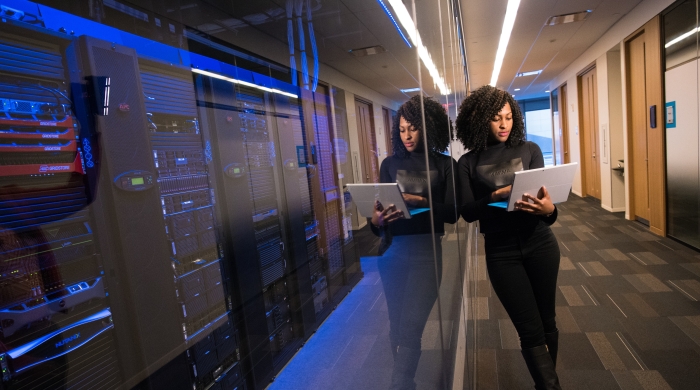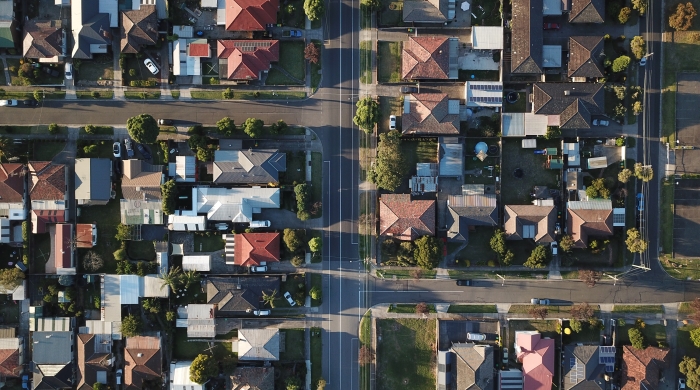
On the Ground interviewed Dr. Diane Hughes and IES-PIRT Fellow Olga Pagán to discuss their research on racial ecology. Their remarks were edited for clarity and length.
Olga, you were trained as a teacher before you joined Dr. Hughes lab and the IES-PIRT program. How does your teaching background and experience influence your work?
Olga Pagán: As a teacher, I saw how students of all backgrounds were navigating and negotiating racial dynamics. I saw it in curriculum, pedagogies, inter-student dynamics, and student-teacher dynamics. I worked in an elementary school with upper elementary children. This is a time when students are very much aware of the world, they’re in the thick of figuring out their own place in the world and their own identity. I watched my students navigate those issues while I thought about how I showed up for those students as a teacher, a woman of color, and as a person in their lives. Racial topics were not talked about explicitly when I was a teacher. I think in 2021, race is more in the zeitgeist.
Seeing those dynamics play out in my classrooms and not having anywhere to read about or discuss or learn about those issues prompted me to think about where I could go in my career to build that out as a system of support for teachers.
In your research and lab work, you both focus on “racial ecology” in different settings. What is racial ecology?
Dr. Diane Hughes: Geographical space, online space, and interpersonal relationships are settings, and those settings have a racial ecology: a dynamic that goes into what they feel like to people who enter them. In community psychology, we have a lot of frameworks that can help us understand what contributes to the way a setting feels for a person who is in it.
We think about, what are the physical features of the settings? Using a school as an example: Who are on the posters in the hallway? Who is on the honor roll? We can also think about what policies and rules and procedures are in place. What are the disciplinary codes that might apply more or less equally to kids of different races? Can boys have braids or dreads? Are all the teachers white? Are all the janitors people of color? All of that contributes to how the setting feels to people of different races.
You can also apply racial ecology to other settings, like a basketball court. Who is sitting on the sidelines? Who is playing basketball? What style are they using to play basketball? Because you could argue that Black people and white people do not play basketball the same way.
The physical space, the policies and procedures and rules, how those rules are applied, the interpersonal interactions, the makeup of different key stakeholders in that place — those all contribute to racial ecology.
Pagán: When we talk about racial ecology, we also need to consider individual mindsets. Where are people in their racial identity development as individuals? Do most of them endorse color blind ideologies or are most of them race conscious. That also makes for different dynamics.
Hughes: Racial ecologies are not necessarily constant. They shift over time. Following the summer of 2020, the racial ecologies of organizations, communities, and schools changed. Every setting has a racial dynamic, whether it's discussed or not. Whether it's discussed is part of the racial ecology.
Changing people's attitudes, beliefs, and behaviors, and improving racial climates can be rewarding yet complicated work. It also can be exhausting. How do you both remain energized and hopeful about your work?
Pagán: I'm currently designing a study that examines how anti-racism, advocacy, and behaviors combat against racial stress. Being able to do something about racism eases the burden. We are looking at a lot of emotionally charged areas, but feeling like we are making movement in the right direction is energizing. I would say that Diane’s lab, the individuals in the lab, and the group we have is also a strong source of support for me. I go to lab meetings and I feel accepted, encouraged, challenged, and positive within a psychologically safe space. There is a personal network component of the work that is not to be overlooked.
Hughes: I do a lot of community workshops on teaching race to children. When I first started leading them, I expected it to be parents of color because they are the parents that feel like they need to protect their children in the context of structural, institutional, and interpersonal racism. That is not who showed up.
I've led a dozen of them at this point. Every time it's predominantly white parents who are lacking efficacy and skill or knowledge. “How do I talk to my kids about this?” Some of them are parents of biracial kids. Some of them are just parents who want their kids to value diversity. They want to know how, but they are afraid. There is fear in raising and discussing the issue of race.
Everyone knows that all the Black kids go to the punishing room in school but nobody says it, right? They think “there’s nothing we can do about it. I don’t know how to change it.” Raising up ways that you can change the racial dynamics and spaces and make people think about it differently is a source of energy for me. The optimism that the work brings is a source of energy too.
I don’t believe we’re going to overhaul the racial dynamics of the U.S., but the work Olga does with the Center for Racial Justice in Education (CRJE), that type of incremental change is also a source of energy. Schools come to them and say “we want to look at racial climate and address it but we don’t know how – help us.”
Pagán: There is a two-pronged approach in how CRJE works with schools. One is talking about the issues and being able to name that race and racial identity are real things. What does that mean for how you interact with your fellow colleagues and their students? The second is then supporting them with frameworks informed by community psychology to say, “here are all the different places in your school where you can look to see how the racial dynamics are playing out. Look at the books in your library. Look at the intergroup interactions among students. Look at how teachers are fairly or unfairly, equally or unequally distributing the punitive discipline to your students. We hold a microscope up to all of the different facets of an ecology to support them in examining their school’s racial climate. We then support them in looking at the policies or practice changes that they can start making to make for a more equitable and just racial environment.
Dr. Hughes, you co-wrote a piece for the Child and Family Blog last year that advocated for intentional parenting for equity and justice. Can you describe this approach and how can parents or caregivers put it into practice?
Hughes: With parents, I start with the fact that race is a socially constructed concept. What bubble you fill in on the census is a predictor for your basic trajectory through life. That’s not to say if you are Black or Mexican you’re going to be on this trajectory. But it’s a predictor of economic outcomes, and whether you live in a single or a two parent or multi-generational household. It’s a predictor of what kinds of school you go to and what kind of neighborhood you live in. It’s a predictor across domains. To pretend like it doesn’t exist is disenfranchising to an entire group of people.
Many parents are not even comfortable with the idea of race, privilege, or disadvantage. Some parenting is reactive: We hope our kids aren’t going to get into drugs or we hope our kids aren’t having suicidal ideation. We’re not going to talk about it, but we hope it’s going to turn out the right way. Lots of times, we’re wrong.
If you want your kids to have particular perspectives and knowledge about race, you have to intentionally set that as a goal and figure out strategies. How are you going to react to situations you didn’t expect? If your kid says “Mommy, don’t all lives matter? Why do only Black lives matter?” then you know what to say, right? You have a script that’s driven by your mission or your goal.
“What do I want my kids to learn?” That’s one of the things we ask parents. Why is it important for your kids to learn about being white, African-American, Chinese, Dominican? What is it that you want your kids to know? Is there anything that you do to help them learn that?
Parents tend to be very passive about what they want: “I put them in a diverse school and I thought they would have more diverse friends, but they actually don’t and there’s really nothing I could do about that.” My position is that you have to be intentional about it.
Pagán: The newer movement in school reform interventions, as discussed by scholars including Dr. Prudence Carter for example, used this term of “race conscious intervention. That is exactly the critique that they level. Interventions that don’t explicitly name race and racism as a problem are not going to effectively address issues of race and racism. If you’re aiming to target inequalities by race and you don’t name race, then you aren’t going to be able to address the inequalities.
What research projects are you both working on now?
Hughes: I’m really excited about one of our projects that is funded by the Spencer Foundation. Working with students and my colleague, Dr. Nancy Hill, we’re creating a public-facing web portal for school administrators, teachers, families, communities that explains the concept of school racial climate.
It will provide tools to assess and think about their own racial climate. We’re doing brief videos with different key stakeholders, some academics and scholars who started working on this issue of school racial climate, and what it's composed of.
The site will also feature perspectives of school personnel, parents, and kids. We’re also going to include a checklist that schools can use to think about their own racial climate and resources for where they can go if we want help with their school racial climate. We hope to have the website available by April.
Pagán: We’re in the midst of applying for funding for a study that uses an original data collection project on teachers. It’s infused by my interest in teachers and how they are navigating and responding to the stressors of both the COVID-19 pandemic and racism related stressors at the societal level.
What resources do teachers draw upon for help? Is it teaching efficacy, anti-racism advocacy, or social support in school or outside of school? The goal is to look at these constructs in a multi-racial sample of teachers. Most of the work on how racial climate influences teacher wellbeing has been done with teachers of color, with a particular lens of recruiting and retaining teachers of color, which is really important. Our national teacher workforce is 80% white, so knowing how these issues impact white teachers is also of interest and a new angle on the research.
Hughes: The visibility of anti-Black racism and COVID posed demands that teachers had to manage in classrooms. The pandemic obviously required them to restructure the whole process of how they teach. That shift was more problematic for some demographic groups of students than for others. The anti-racism activities made it so that teachers can no longer ignore issues of racism as they emerge in their classroom or in their teaching. You can’t have all this change going on in the world and ignore it in your classroom.
Related Blog Posts
Q&A: Dr. Rachel Atkins
In 2020, Dr. Rachel Atkins received a grant from the Kauffman Foundation to fund the development of the Workshop for Advancement of Research on Racial Equity in Technology Entrepreneurship, through the Center for Critical Race and Digital Studies (a center within IHDSC). On the Ground interviewed Dr. Atkins about what inspired her project and how the research community can contribute to the workshop going forward.
The State of Black Suburbs
"For many folks, when I start to talk about the Black suburban experience, they think that it's this moment of meeting of white and Black, of distance coming together. But there's a far more nuanced and complicated reality." Drs. L'Heureux Lewis-McCoy and Kimberley Johnson received seed award funding for "The Black Suburban Governance Project" in 2020. Along with PhD candidate Kiara Douds, they discussed their research approach and early findings.



